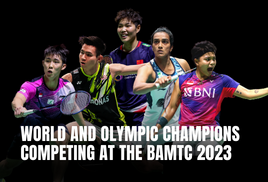GENDER EQUALITY IN SPORTS AND BADMINTON

Gender equality in the realm of sports has been a topic of discussion for a very long time. The rules of sport are the same however, the conditions are not. It was only in the 2012 Summer Olympics where, for the first time, women competed in every sport at a Summer Games. Female athletes in general, have lower salaries, lower prize money, less sponsors, and little media attention than their male counterparts. The discrimination is very much still alive in many sports, and it is a continuous battle for equality.
It’s present in all sporting entities, from football, basketball to badminton. In 2015, after the US women’s football team won the World Cup, it was found that they were only paid a quarter of what the men earned despite historically having had greater success than their male team. In 2019, the United Nations stated that top male football players such as Lionel Messi earn around $84 million a year, whereas in women’s football, the combined annual salary of 1,693 players in the world’s top 7 women’s football leagues, earn a combined $42.6 million. But the problem is more than the wage gap; for example, most male athletes are more marketed than women therefore granting them more sponsorships and brand deals and women’s sports games also receive less viewership due to the men’s games advertised much more heavily.
Badminton is not immune to this problem as well. There have been many issues in regards to gender inequality in the sport. Back in 2011, Badminton World Federation (BWF) introduced a dress code requiring the female players to wear dresses and skirts to “attract more attention” towards the sport. Shorts or long pants are also allowed but only under the skirt; however this was met with many criticisms as many players pointed out it’s sexism, and not just that but the rule can also affect their performance. However, after the backlash, they reviewed their rules and have cancelled the ruling.
The inequality is still there in the sport, but there have been many efforts put in place to help improve the situation. BWF has been pushing for greater “gender equity” within the sport through “greater awareness of the need to provide opportunities for women at all levels of badminton.” Just this July 2020, BWF staged its 81st BWF Annual General Meeting, where “the Membership approved the proposal to ensure geographical and gender representation on the BWF Council” through “establishing a framework that guarantees global board representation and a minimum representation of each gender.” This new rule ensures that at least 30% of each gender is on the Council and also within the representatives from each continental region. With the addition of proposals and rules such as this, it is a step forward in the right direction in which we can see greater equality amongst all players.
Recently, Tai Tzu-Ying won against her male opponent. In a rare occasion, the world No.1 female badminton player played against male players in order to keep her in shape for her next tournament. Playing these types of matches together and competing against one another shows that female players can compete with their male counterparts and are very much capable of doing so, and winning.
There’s still so much to improve on if we want to achieve gender equality, but with the addition of more inclusive rules, and greater accessibility for the sport, this helps to encourage more women and young girls to participate in the game of badminton. We must continue the effort to make sure that gender does not become a barrier for their love and success in sports, especially in badminton.





